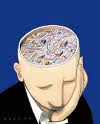The Times had announced plans to put its content behind a "pay wall". These are the first results.
 On the site of Benedict Raphael, who has made a good review last week, we learn that there were 105,000 sales (not to be confused with readers), half of which corresponds to monthly subscriptions and the other half is transactions per unit (£ 1 for one day). "The Times has managed to turn only 0.5% of its 20 million readers online." ( Also on paidContent)
On the site of Benedict Raphael, who has made a good review last week, we learn that there were 105,000 sales (not to be confused with readers), half of which corresponds to monthly subscriptions and the other half is transactions per unit (£ 1 for one day). "The Times has managed to turn only 0.5% of its 20 million readers online." ( Also on paidContent) A "pay wall" thus means drastic decrease in attendance (but a "community of high quality, very much involved."). What is telling in The Gaurdian that this is not a good business model. (via Benedict Raphael). "The profitability of the initiative seems doubtful now." publishes FPJQ .
Clay Shirky this morning writes that he does not believe it: with the "commodisation" information [" convenience" is borrowed from English and means "to make commonplace" with little commercial appeal, as the "commodity"], there is no way around the disturbing fact that the mass no longer wants to pay for content. The wall is only paying out those who do not want to pay and retains only those for whom the information, that information is not a commodity. It perpetuates the notion that newspapers can maybe get away without major changes.
It is indeed strange to think that, according to figures showed that the total wall charge can support a writing as The Times. If the Duty can successfully see a profitable avenue, with a partial wall, is that their editorial structure was already subject to the budget thin. The Times change so that it would face the same.
It is clear that the business model based on "average" is no longer in a world of long tail. And training may not be forthcoming: as the forward section is useless (you must be a subscriber to read the article), fewer people will cite the paper, leading to a downward spiral of loss notoriety.
But the problem now seems to reach even the newspaper sites open: unique visitors decline worldwide (according to Nielsen figures, compared to Google trends, such as compiled by Jeff Mignon last month). Information is a "convenience" [a product with little differentiation]. Yes, but what now? It sits on the shelf .
( image source)
0 comments:
Post a Comment